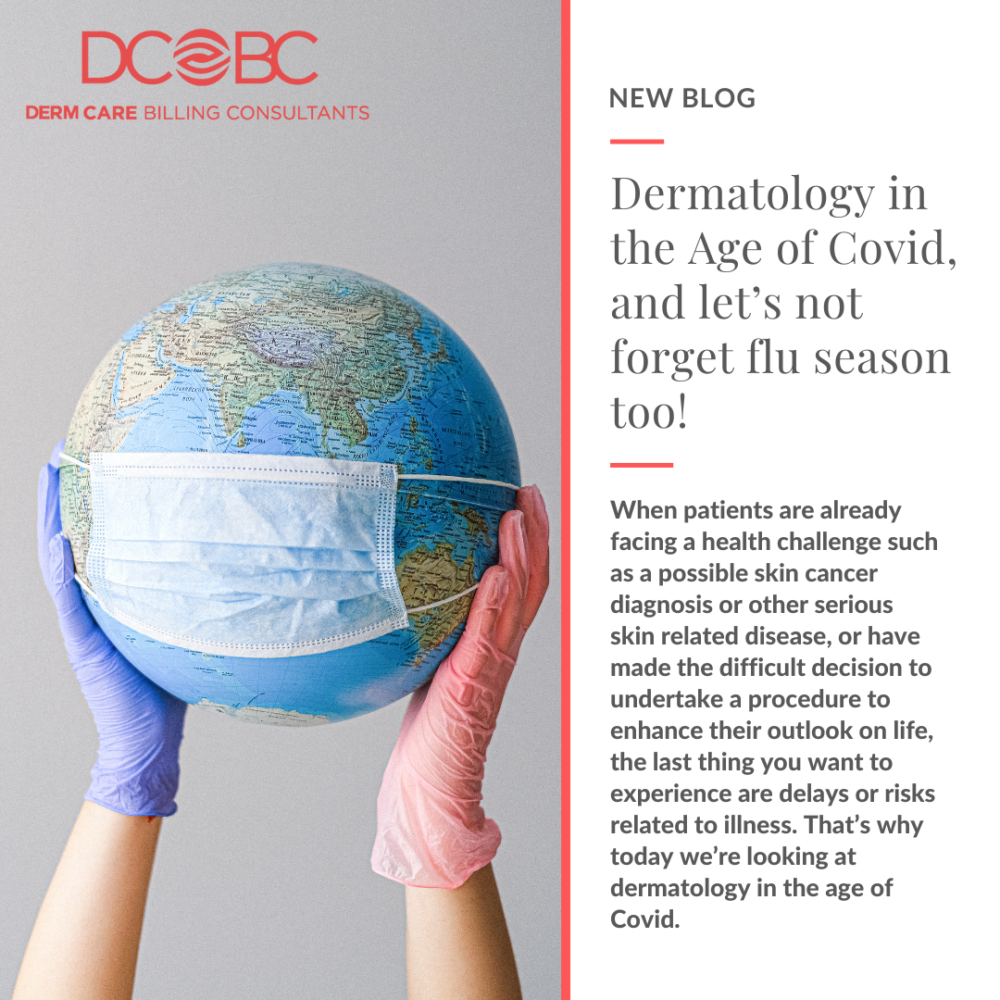Dermatology in the Age of COVID, and Let’s Not Forget Flu Season, Too!
All medical practitioners, including dermatologists, consider the role that managing COVID appropriately as part of their practice plays in the day to day management of a clinic. When patients are already facing a health challenge such as a possible skin cancer diagnosis or other serious skin related disease, or have made the difficult decision to undertake a procedure to enhance their outlook on life, the last thing you want to experience are delays or risks related to illness.
Whether your patients are concerned about COVID, or even just a nasty case of the flu, which by the way can be every bit as dangerous as COVID to some people with a compromised immune system, they need to know that when they enter your dermatology clinic, they are in good hands and safe every step of the way. We’ll look not only at some of the ways they are protected, but also the impact that COVID had on the practice of dermatology.
Effects of COVID on Dermatology Initially
First, let’s start by examining the role that the initial outbreak of COVID played in how skin health was managed. According to the National Library of Medicine, as a result of a survey of dermatologists around the world, a significant decrease in the number of patients seen during COVID was noted. An increased risk of missed melanoma and nonmelanoma skin cancer diagnoses was also noted – likely as a direct result of clinic closures and reallocation of dermatology resources – along with increased “findings of a wide range of skin manifestations associated with COVID-19.” So we know the initial impact of COVID on dermatology practices led to a reduction in patients seen and an increase in various skin conditions that were directly related to COVID. Many respondents reported, too, that their scale of practice was diminished at least in part due to the additional precautions required to manage in person appointments during COVID (to ensure the safety of all patients) and so that they could prioritize the treatment of urgent skin issues.
Recommendations for Dermatology Practices
Next, it’s important to note that the American Academy of Dermatology Association, in order to help ensure clarity and consistency around dealing with COVID in a clinical setting, released a number of recommendations for dermatology practices to follow. A standard of practice was determined with a focus on understanding the level of risk within both individual practices and in their greater community setting. Directives on the steps that could be taken to manage both patient and staff risk, the use of PPE and even the continued use of immunosuppressive therapies during COVID were also shared with dermatology clinics across the nation.
Consider Offering Teledermatology
Throughout the COVID crisis, we also saw a significant rise in the use of teledermatology. In some instances, teledermatology provided an efficient and effective tool for doctors to diagnose and prioritize those patients who needed to be seen in person, quickly, in order to receive treatment. In the clinic, those patients then – as now – could expect to receive treatment from physicians and nursing staff who followed COVID protocols, were masked and who practiced enhanced safety in the clinic or hospital setting, doing their best to ensure the continued health and safety of all. Dermatologists are encouraged to use teledermatology during this year’s potential wave.
COVID Impact on Patient’s Current Medical Treatment/History
Dermatology care isn’t just about what to expect in the clinical setting however. Because of the variety of conditions treated, patients also have concerns about the impact of COVID and/or cold and flu season on their specific dermatological condition. Particularly those patients whose conditions are being managed by biologics. Some patients, for example, may wonder whether they should receive an annual flu shot, and/or continue accessing COVID related vaccines and boosters. Here is what some of the research has found (or suggests) according to various sources. While we will cite just a few examples here, it’s important that patients speak with their own dermatology practitioner to determine the course of action that’s right for them.
Findings:
- In some patients receiving methotrexate, there appears to be a benefit from suspending treatment for a period of time following administration of the flu vaccine.
- For some patients receiving biologics, their response to vaccination appears to be about equal to that of the general population.
- Approximately half of the patients on cyclosporine do NOT receive a “seroprotective response” after vaccination.
- Patients and doctors together must determine the risk of psoriatic flare during any suspension of treatment before, or after, vaccination along with the possibility of failed seroprotection. This means there is certainly much to consider and a “clinical judgment tailored to each individual” is recommended.
In short, whether we are discussing COVID-19 or “regular” cold and flu season, patients, practitioners, the operations of the clinical practice and the staff team who work in them must all work together to ensure the safety of all and assess the risks of treatment. Like any medical practice, dermatology is bound by a significant set of rules, guidelines and expectations that will govern not only an appropriate level of care but how that care is received in a dermatological setting. However, with the additional risks that COVID presents in terms of skin conditions that arise from having it OR the suspension of treatment for skin conditions while receiving vaccinations for COVID or flu, there are significant additional considerations for dermatologists and their patients. Dermatology in the age of COVID is challenging. As cold and flu season also rapidly approaches, encourage and ensure you have a frank conversation with your patients about their individual risks.





